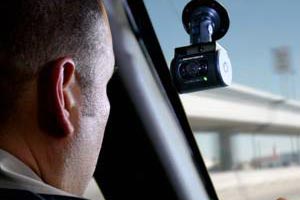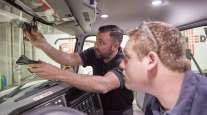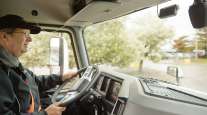Trucking Firms Find Success, Challenges With Driver Cameras

The same sort of video technology that has been reshaping police work in the United States now is poised to transform one of the country’s less-appreciated occupations, heavy-duty trucking.
A growing number of carriers, including companies in Wisconsin, are outfitting their trucks with dual-lens cameras that simultaneously capture video of the road ahead and the driver at the wheel.
Some drivers balk at what they regard as Big Brother-like intrusion, but trucking executives applaud the technology. They say it improves safety, exonerates drivers who might otherwise be blamed for crashes and provides valuable information in the event of lawsuits.
“Our safety record has been better and … it has saved our butt on a handful of accidents where we were not at fault, but without the video it could have been a ‘he said, she said,’ ” said Jeff Shefchik, president of Paper Transport Inc., a Green Bay, Wisconsin, company that began installing cameras in its 500 trucks two years ago.
“It’s been just, I would say, amazing as far as the information that it provides to us,” said Dan Millis, safety director at Millis Transfer Inc., a 750-tractor, over-the-road carrier based in Black River Falls, Wisconsin.
Nearly 400,000 trucks in North America now have cameras installed, consulting firm Frost & Sullivan estimates. Lytx Inc., which Frost describes as the market leader in the field, says it grew by almost 80% last year.
Phoenix-based Swift Transportation, with 18,000 tractors, is one of the country’s largest carriers. The company is just finishing the task of equipping its entire fleet. XPO Logistics of Greenwich, Connecticut, has cameras in all of its 8,440 less-than-truckload tractors.
Swift ranks No. 6 and XPO Logistics ranks No. 3 on the Transport Topics Top 100 list of the largest U.S. and Canadian for-hire carriers.
New Jersey-based NFI Industries began placing the video eyes in its 2,200 trucks in 2014, and has seen accident frequency cut in half and insurance costs drop by probably 25% to 30%, said Craig Bollinger, senior vice president of risk management. NFI ranks No. 27 on the for-hire TT100.
The technology also delivered a result unprecedented in Bollinger’s experience: “We had one month where we collected more money for damage to our trucks than the damage our trucks had caused.”
Linked to accelerometers, gyroscopes and GPS equipment, the cameras function as event recorders. If the truck is running, they’re running, but they can't be used to spy on drivers, executives say. They only capture video when triggered by such things as hard braking, rapid acceleration or swerving from side to side.
Then, the systems capture several seconds of video from before the event and a few seconds after. That lets analysts at vendors such as Lytx and SmartDrive Systems Inc. — and ultimately safety staff at the trucking companies — see what led to the result: The minivan that ignored a signal and crossed an intersection right in front of an oncoming semi, the car that swung through three traffic lanes and into a truck’s path, the rumbling 18-wheeler that drifted onto the shoulder and then off the highway itself.
Also recorded are the reactions of the trucker. Sometimes they’re good: He alertly dodges around the sofa that falls off a pickup or brakes promptly to avoid rear-ending the car that just cut him off.
Companies use such videos to recognize drivers in front of their peers.
But sometimes performance falls short. The cameras have captured video of drivers holding cellphones and talking on them while rolling along, running red lights, steering with their forearms resting on the wheel and even falling asleep.
Armed with video, which Shefchik called “a very powerful training tool,” companies coach drivers to do better. And even in cases where a trucker is shown to be at fault in a crash, video has value: “You know to get that claim settled as quickly as possible,” said Dave Manning, president of TCW Inc., a Nashville, Tennessee, carrier with about 300 tractors.
The rising number of cameras in commercial vehicles notwithstanding, there is plenty of room for growth. The United States alone has some 3.6 million heavy trucks, most of them tractor-trailers, and millions more commercial vehicles. Trucking executives say the trend will spread across the industry.
“I would expect that it would be mandatory at some point, just like they’ve done with the electronic log [books],” Millis said.
Large-truck involvement in fatal crashes across the U.S. has dropped nearly 73% since 1975 on a per-mile basis. It now differs little, mile for mile, from the automobile rate.
Still, more than 3,700 large trucks were involved in deadly crashes in 2014, the most recent year for which data is available. Some 3,900 people died in those accidents. Most of them weren’t truckers themselves, but the occupation remains dangerous: Big-rig drivers are seven times more likely than the average worker to die from on-the-job injuries.
The admittedly limited experience of trucking companies to date, meanwhile, as well as the also-limited academic research, suggests that cameras can make highways safer.
A federally funded study at Virginia Tech tallied safety-related events — again, things like hard braking or sudden swerving — at two trucking companies before cameras were activated and after. With the cameras turned on, and — importantly — trainers coaching drivers in the wake of mistakes, safety-related events declined by 52% at one company and 37% at the other.
The follow-up coaching is critical, said Jeffrey Hickman, a research scientist at Virginia Tech and the lead author of the study. Only truckers who received face-to-face coaching about their driving changed their behavior, Hickman said. Drivers who had the video systems in their cabs and knew they were there but got no coaching, “didn’t change their behavior at all,” he said.
About 90% of crashes involve human error, and video monitoring can help correct bad habits of even experienced drivers, said Hickman’s co-author, Richard Hanowski, director of the Virginia Tech Center for Truck and Bus Safety.
He likened the approach to athletes watching game film.
“You don’t know what you don’t know, and if you’re making a mistake and you don’t know you’re making it, how can you improve it?” Hanowski said.
At Roadrunner Transportation Systems, a Cudahy, Wisconsin, trucking company that is among the country’s 20 largest, a recently launched test in 30 tractors has shown a 60% to 80% drop in triggering events such as following too closely or hitting the brakes hard, said Clay Merches, vice president of safety.
Roadrunner, with 4,500 trucks, has been so impressed with the results that it is planning to take the technology fleetwide, said Robert Milane, executive vice president of risk management.
Roadrunner ranks No. 16 on the for-hire TT100.
That won’t be cheap. The cameras cost several hundred dollars each, plus a monthly service fee of $35 per unit, according to Merches.
Roadrunner also could experience more than the usual amount of pushback over the technology, as most of its drivers are independent contractors with their own trucks, rather than company employees.
The video-monitoring trend, of course, undercuts the notion of the gypsy-hearted trucker celebrated in country music. That’s a myth anyway, but many resent the idea of being electronically tethered to the safety department.
“I think that’s kind of invasion of privacy,” 35-year trucking veteran John West said as he paused at the Love’s Travel Stop at I-94 and Ryan Road in Oak Creek, Wisconsin. West, 61, of Cincinnati, said his company has yet to install cameras, and he doesn’t want that to happen.
“I don’t think I’d be too happy,” he said.
And with qualified truck drivers in short supply, some companies hesitate to add inward-facing cameras. TCW tested them in its Memphis operation, but after “a significant number of drivers quit,” the company opted to go with outward-facing lenses only, Manning said.
“In the tight driver market, we just made the decision that we don’t want to be the leader on this,” he said. “We need more fleets to adopt it and then we’d ultimately like to have it in our trucks, but we’d like for it to be widespread so that it’s not so easy for them to go and find another job where there’s not a camera.”
Green Bay-based Schneider, with more than 10,000 tractors, also is opting for forward-facing cameras only, but with a gradual roll-out. The company is looking to have them installed in all new truck purchases.
Schneider ranks No. 7 on the for-hire TT100.




